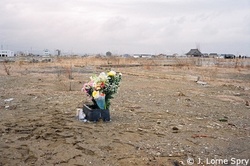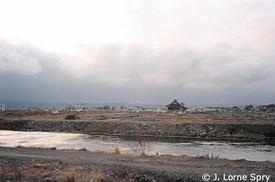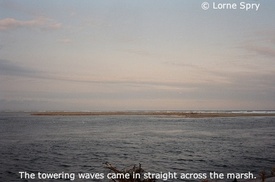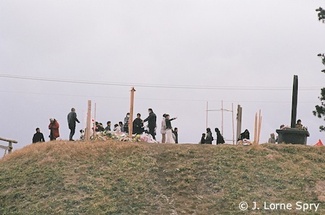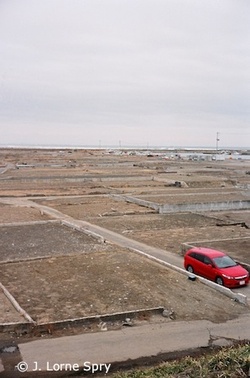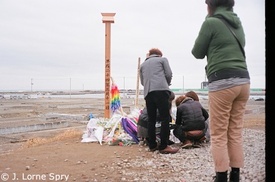Just over a year ago in the northeast region of Japan known as Tohoku, Japanese as well as ex-patriots from around the globe had their lives changed forever—or died. For some survivors the change was abrupt and catastrophic—lost friends, relatives, wives, husbands, children. Gone were their homes, businesses, work places, careers, farms, school life, oyster beds, vessels of all types and perhaps a peaceful retirement. In some places, an inordinate number of children were swept away along with their grandparents. The rest of Japan was to learn that is was because the north has retained much of the timeless, family way of living. Small children were being cared for by ba-chan and or oji-chan while papa and mama were working.
Months later we were still learning about what happened to people we worried about. We still wonder about those with whom we have simply lost contact in life. I received an Email from a young student who wrote, “My house was floated, and all my friends are died.” The anniversary has been called a remembrance. There was a lot to remember that day. Most of us had been remembering all year.
A year ago, some Japanese politicians were making hay in the wake of the nuclear incident in Fukushima. They invented a new word—“fly-jin”. This plays on the colloquial word for foreigner—gaijin. These politicians were intent on portraying faint hearted, panic stricken foreigners abandoning their various posts and responsibilities. They did this in spite of the fact that many in the first wave boarding planes, trains and buses were Japanese. Many were simply trying to get their very young children out of the way of the plume that was blowing directly into Tokyo from the blasted nuclear facility owned by the utility company known as TEPCO. Many people on the Kanto plain were able to travel. Unlike the northeast, the public transport system was still running. Street interviews of the time reveal that many people were not trusting or believing what government ministries were telling them—or not telling them.
Much of Tohoku was completely cut off from the rest of the country. Virtually all services such as gas, electricity and fuels were unobtainable. Much of the cell phone service was knocked out. Most news and information came from battery powered radios. Transit ground to a halt. Many coastal communities that had been shattered by the tsunami were accessible only by helicopter. The Japanese Self Defense Force swung into action and together with Japanese and foreign volunteers, more and more areas were gradually assisted amid their misery and shock. The scale was so overwhelming that in some places relief was a long time in coming. Day and night, Sendai city was awash in the noise of helicopters and sirens.
Very soon after the quake, Prime Minister Kan’s office was informed that TEPCO planned to abandon the Daiichi plant. Kan, an engineer by training,* was told by his science advisors that if current trends continued, plans for evacuation of Tokyo were needed—a metropolis of 13 million people. Today, too many people remain unaware that a disaster of truly apocalyptic proportion was only just narrowly averted.
Kan boarded a helicopter and flew out to the Daiichi site. His angry demands, as well as a plant manager who disobeyed TEPCO’s top executives, saved Japan from becoming a failed state. Some politicians were only too content to defame fly-jin instead of focusing their attention on a corporate culture that had meddled with official documents, and over decades had tried to cheat nature.
Around the same period, Prime Minister Harper announced that the Canadian government saw no need for helping Canadian citizens out of the country. The French were sending in aircraft to fly their people away from three nuclear meltdowns as well as a whole region of Japan that was not functioning. Germany moved its embassy to Osaka. The Australians had rescue teams in the northeast and were on the look-out for their ex-pats and others who might be dead or injured. And already, some people in the true north strong and free were beginning to grumble about people who had left the country on their own accord and now wanted maple-leaf-help just because there had been a triple disaster. I guess they had never heard of “tax treaties.”
Foreign affairs was on the phone talking to those Canadians who could manage to call out. These people were told that they could leave on a standard flight if they felt the necessity, although the Canadian government was not advising it. “Affairs” explained that ex-pats in the Sendai area could catch a regular flight at Sendai airport. I guess that no one in Ottawa had watched the tsunami on TV. They must not have had access to satellite reconnaissance. If so, they would have seen that Sendai airport was underwater and full of twisted airplanes and heaps of smashed cars. Transport in the area was non-existent. A city of a million people was moving around in starlight, or sheltering in relief centers. For a time, Sendai International was not even a helicopter pad. Ironically it is adjacent to the community that Mr. Harper visited on the day of the anniversary, and where he commented on the extent of the still very evident destruction.
It may be ungraceful and petty to think of some of these things during such an anniversary, but they did come to mind. But then perhaps it can be expected when a person spends an entire year remembering the more awful things and being unable to forget them. Out of kindness, one friend has suggested that I try to put it all behind me. For millions of people, March 11, 2012 was not so much a day of remembrance, but rather a day of mourning.
The Tohoku region has been under a shadowy spell of recent death, suffering, grief, and destruction. Hundreds of thousands of the most affected have been stalwart, and brave. Each day they put one foot in front of the other in an effort to keep families and communities together. Some people choose to move away from villages and towns in order to seek work and educate their children. Hundreds of kilometers of rail is missing and may never be replaced. Japan Rail East has declared restoration of service to be unprofitable. As a result, some coastal communities have become just that much more isolated—rail being a way of life in most of Japan.
Some smaller villages in coves that were shelled out by the waves are being left with aging populations living in temporary housing complexes. They have expressed their unwillingness to move to the city centers and occupy public housing projects. They prefer to live out their lives in the places where they were born—to live in a community of their peers near the sea on one side and the towering green hills on the other. Even as communities bind together, pieces are also breaking away. But all are putting a face towards life that has astonished the world. And there is no spin in that story.
Millions live in an altered state of mind quite unlike before the disaster. Added to this—for anyone following the news and poking a little further ahead than what the government, its agencies and TEPCO feed us—there is the constant nagging thought that the wrecked nuclear facility is a time-bomb that is still potentially lethal enough to turn most of Japan into uninhabitable wasteland and contaminate virtually all of the northern hemisphere inside of a week. The predicted quake in Tokyo Bay could play a part in ruining this country for all time. And there is no spin in that either.
Specifically, Mr. Harper visited the fishing community of Yuriage. He was taken to a hillock where he placed flowers at a modest shrine. The hillock has a commanding view of the scoured area that was once a beautiful marsh, a little fishing port and home to hundreds of families. I used to ride my bicycle there for exercise. I’d cross the canal and ride towards the airport—sometimes stopping on the way to savor the atmosphere that reminded me of my boyhood years ago.
Across the Pacific, in another lifetime, and on another bike, I sometimes rode to the fishing port of Steveston, Richmond, B.C. I would watch the Nikkei mend their nets and ready their boats. So Yuriage was familiar and as peaceful as the days of my youth in the mouth of the Fraser River. Peaceful…despite the odd airliner climbing out over the sea. There were birds in the marsh, and members of the university rowing club skimmed up and down the canal in their sleek racing craft. There was more than a good taste of the bucolic.
The day after the quake, I left my family and tried cycling to Yuriage. I rode on levees to the sea at which point I could go no further. I could not cross the mouth of the Natori river. The bridge on Route 10 was being guarded by army reservists. The destruction of another community named Arahama was all around me. Two lorries and their drivers were stranded at the foot of the bridge in a scene that was filmed from a helicopter and transmitted around the world. I looked over into Yuriage and saw the fires there. Smoke palled over the area. I then turned around and went home—and cried. What I had not seen the day before I could imagine without effort.
Exactly a year later, the bridge over the Natori was open to traffic; the roads were clear right up to the sea front. Nothing remains but the foundations of houses, net sheds and so on…along with great neat stacks of gathered debris. I made my way to the hillock shrine. A schoolgirl choral group arrived in buses. In their school blazers and skirts they braved the chilly wind and performed the rites of song. Quiet people were coming to place flowers and pray—many of them finely dressed to honor the occasion. Out in the distance, family survivors and friends could been seen kneeling in the cold sand … praying among the foundations that marked out where people had lived and perhaps died—like the mother who rushed her two children to safety and then was never seen again.
It was a cold, overcast day of blustering winds with the sun sometimes peering through darkening clouds. Many young people were there … quiet and subdued … praying and scanning the expanse where they may have gone to school…where their grandparents had lived…where their houses had been “floated away”…where their friends may have died.
A thin rain came down as darkness fell … as the lights of cars appeared marking their way across the barren network of roads. As I stood on the hillock, I stopped thinking about governments, spin, nuclear power-plants, scandal, deceit and blunder. I was remembering—again. I gazed towards the relentless waves where once the marsh obscured the shore. I caught sight of the empty harbor. I turned again and faced a scene that was too much like two cities much further south over sixty years ago. A hawk circled silently high above in the gusty air. Yuriage was once again peaceful, but in a different way.
* Ex-prime minister Naoto Kan is currently leading a faction within his party that wants nuclear power plants in Japan eliminated. Kan was wrested from power when he declared that getting rid of the nukes was going to be policy in his administration. And so it goes.
© 2012 Lorne Spry


